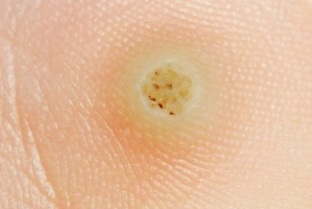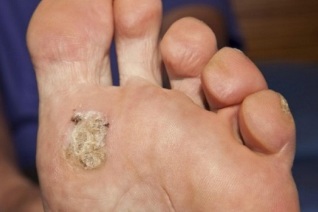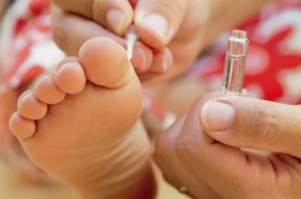
If a hard and rough papule with a rough tip is visible on the soles of the feet, then this is a plantar wart or callus. The differences are significant, mainly in terms of origin and methods of treatment. The wart grows like sharp thorns in the inner layer of the skin of the foot, causing severe pain. Doctors recommend removing this skin if your shoes are damaged and become inflamed.
Foot outlet appearance
oneMost common wart grows on the leg, into the dermis. The reason for this is that hard surfaces are pressed from the tumor: shoes, various coatings on which we walk. New growth cells appear from the soft tissue of the skin. In the photo of the plantar wart, a dense plaque or cylinder is visible from the outside. The surface of the gel is not without skin lines, consisting of scales of the horny substance. The proximal skin changes: it becomes denser, covered with a layer of keratin.
What a plantar wart looks like:
- node or plaque raised above the epidermis 1-5 mm; The shape is
- round, oval or polygonal; The surface
- is hard and rough to the touch; color
- pink, yellow-white or gray-green; Forming diameter
- from 1 to 20 mm; Papillary pattern
- missing;
- edges well defined.
A wart on the leg is characterized by acute intermittent pain, up to a temporary disability.

Collection occurs in areas exposed to intense pressure and compression. Typical localization of the wart on the fair: heels, foot pads and toes. Painful and difficult to remove formations are visible at the edge of the nail and under the nail plate. Inside all types of warts are blood vessels that feed on living tissues, cells that multiply intensely. Small black dots appear on the surface - blood clots in the capillaries; they may bleed when the coil of the stratum is cut.
Plantar warts are most common in school-age children. In about 30% of patients, such formations pass on their own within the first year. However, it is recommended to start treatment when the first symptoms appear, especially if the plantar wart is injured, or if there is a high risk of the surrounding people becoming infected. The infection is also dangerous, when a group of formations is visible in one area, individual papules merge with a mosaic plaque. Wart- manifestation of the papilloma virus
The skin on the feet is often damaged, compressed and sweating while wearing tight and uncomfortable shoes. If thin-walled blisters with clear liquid inside are visible, these are corns. Sometimes there is a layer of keratin on the surface, but the normal skin lines remain.
The appearance of a wart on the soles of the feet is not initially noticed or is considered a callus formation. It is necessary to carefully observe the surface of the gel and pay attention to the characteristic signs. This is severe keratinization, lack of skin lines, salty when the surrounding skin is compressed. Here are the results of active reproduction of the papilloma virus in living cells of the epitheliiam.
Causes of plantar warts:
- Papilloma virus (HPV) virus infection;
- weakening of local and general immune defenses;
- activation of the virus, penetration into epithelial cells;
- increased multiplication and rapid keratinization of infected cells.
Papilloma viruses infect the 1st, 2nd, 4th, 27th and 57th cells mainly located in the skin of the foot. The type of plantar vegetation of viral origin belongs to simple formations (normal, vulgar). According to the International Classification of Diseases, they are infectious and parasitic diseases. Class ICD-10: "Viral infections characterized by lesions of the skin and mucous membranes. "
Simple warts are benign epithelial tumors. They are not a health hazard in the first place. Such growth is sometimes malignantly transformed into a cancerous tumor. This type often triggers HPV types that are established to be at high risk of developing cancer.
Foot wart treatment
After infection, the incubation period begins: the papilloma virus invades cells, "reforming" their reproduction and development. Much more often, the infection becomes latent and in a state as inactive as it can be throughout the life cycle of the organism. The immunity in this case suppresses the papilloma virus, puts it in sleep mode without special therapy.
Plantar warts may appear 3-10 years later or appear several weeks after infection, then disappear in the first year or within two years.
Not everyone is ready to wait, relying on spontaneous healing and cleansing the skin from growths. Many go to the doctor at the first sign of HPV infection. Dermatologists recommend the use of modern methods to remove warts, suggest methods for antiviral therapy, strengthen the immune system of the skin and the whole body.
If it is necessary to select an adequate therapy to establish the type of HPV, the doctor prescribes some additional studies. A biopsy is performed to collect histological material, an analysis is performed to determine antibodies to the papilloma virus.

Treatment options:
- Use special medications for plantar warts. Dissolution and exhumation of dead cells occurs.
- Laser firing of simple neoplasms with scab formation, under which the cure is performed. The crust disappears 7-10 days after the procedure.
- Cryodestruction with liquid nitrogen. Large warts are removed in some procedures. When exposed to low temperatures, a bubble appears, as happens after burning.
- Electrocoagulation using an electrode through which a high-frequency current is applied to destroy pathological tissues. Painful procedure accompanied by strong burning skin odor.
- Remove surgery. Drug injection
- .
At the beginning of treatment, it is recommended to use a special plaster at home. This affordable remedy is used after soaking the wart on the foot with warm water, and cleaning it from the keratinized layers using nail scissors and pumice. A patch is then applied. The course of treatment lasts an average of 1–3 months.
CoscPapilloma viruses can survive in the environment for a long time. It is necessary to keep the feet clean, do not go without shoes, especially in public lockers, bathrooms, in the pool. Special slippers need to be used to protect the soles of the feet from contact with surfaces contaminated with particles of other people's skin. Also, do not wear other people's socks and shoes.
Do not scratch the wart, otherwise similar growths will appear on other parts of the foot.
viruses are highly contagious. Disinfecting accessories for hygiene functions and daily medicines. Socks and towel should be thoroughly washed with warm water, scissors, nail file, pumice stone disinfected. Be sure to wash your hands with soap and water after contact with the education, various medical procedures.















































































